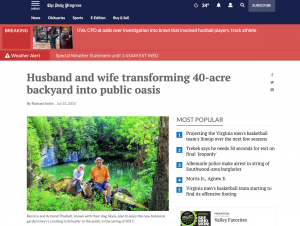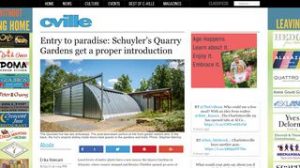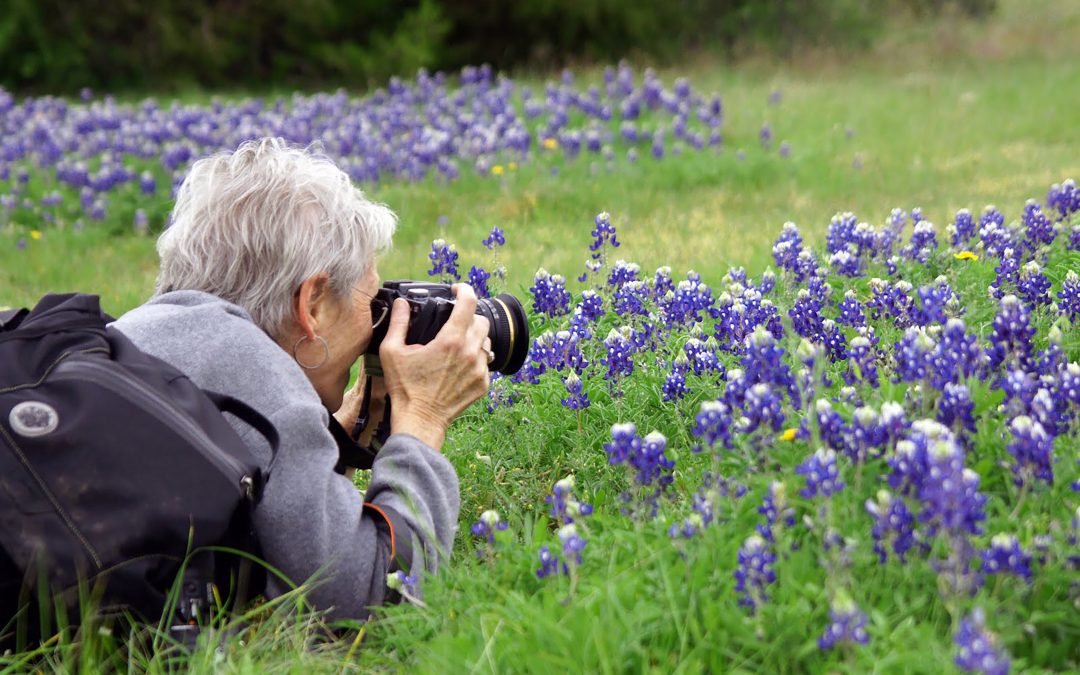
Mar 8, 2021
Cynthia Wood (seen here photographing Texas bluebonnets) will lead a wildflower walk at The Quarry Gardens on Wednesday, April 14, at 10 a.m. Cynthia’s delightful, authoritative Virginia Wildflowers blog has earned 4,000 followers and 14,000 monthly readers on Facebook.
If phenology is a guide, participants may expect to see in bloom—and learn from Cynthia about—Wood anemone, Pussytoes, Wild columbine, Green and gold, Dwarf larkspur, Wild geranium, Alumroot, Bluets, Dwarf crested iris, Golden ragwort, Native phlox, Mayapple, Solomon’s seal, Wild pink, Bladdernut, Spring beauty, Foamflower, Mountain and Perfoliated bellworts, Heartleaf, Golden alexanders—and many others.
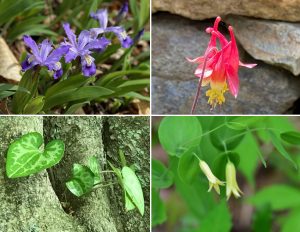
Clockwise from top left: Dwarf crested iris, Iris cristata;
Eastern red columbine, Aquilegia canadensis;
Perfoliated bellwort, Uvularia perfoliata;
Virginia heartleaf, Hexastylis virginica.
Reservations are $15 per person, payable online. Sign up at quarrygardensatschuyler.org/visit.
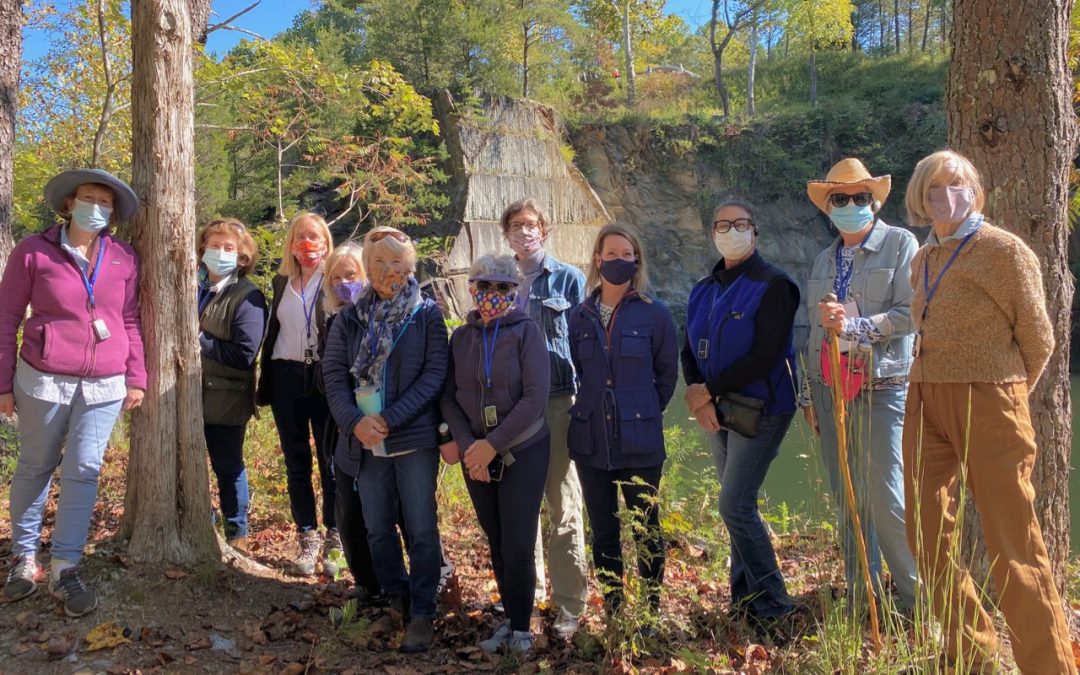
Jan 4, 2021
Thanks to Covid-19, our fourth season was a whole different experience.
Visitors: Only 350 joined us for guided tours—which we curtailed after a while. Of the 29 large groups that reserved, 27 canceled; the photo shows members of the Albemarle Garden Club on October 5. Of the Friends who visited independently we have no count, but we’re glad the QGs were here for them.
Volunteers: Our loyal volunteers contributed nearly 400 hours assisting the Center for Urban Habitats team with planting, grooming, and management of the ecosystem galleries. Besides working with Rachel Floyd on Friday mornings, several adopted favorite areas of the Gardens to monitor and manage independently.
Champions were Julie Farrell and Taylor Randolph, each of whom contributed nearly 60 hours. Volunteers came from Master Gardener and Master Naturalist units of both Albemarle and Nelson counties, the Bluebird Society, and United Way. During the summer, we were fortunate to have as intern Will Jones, a rising senior at Western Albemarle High School.
Visitor Accommodations: The Picnic Pavilion was completed and landscaped. Those who used it this season enjoyed it, and we look forward to many more meals and meetings there in 2021. The tables accommodate up to 40—same as the classroom.
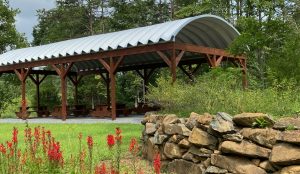
Picnic pavilion seats 40.
Plants: Thanks in part to a generous grant from the Rivanna Garden Club, we completed construction of a deer exclosure by the south quarry pool. It protects and exhibits native species we have otherwise been unable to save from browsing. Planting is complete and, by late spring it should approximate what we had in mind. Controlled burns during the spring rejuvenated the parking lot islands and the prairie below the quarry overlook platform. New roadside prairies were planted along the driveway, and rain gardens were planted near the picnic pavilion.
Wildlife: Three red fox kits started life in a den in the big rockpile east of the Visitor Center. A record 45 bluebirds fledged from the nine nest boxes at QGs and on the adjoining conservation site; Claire Waters and Gareth Hunter of the Bluebird Society tend the boxes.
Explorers: With CUH surveys completed in areas that buffer the Gardens, and 13 miles of hiking trails built through the remainder of the 600-acre property, we have created a new category of membership—Quarry Gardens Explorers—to provide access to those remarkable ecosystems. Explorers may follow the big new trail map up the mountain and along the ledges above the Rockfish River most any time. There’s much to see along the acidic cliffs and boulder forests.
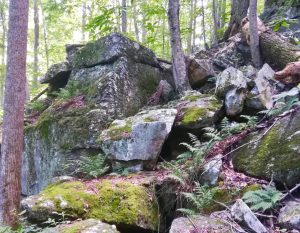
Cliffs along the Rockfish
Research: Planting was completed in the native lawn study plots, and volunteer Ron Fandetti has helped us monitor them. The Blue Ridge Mycological Society continues to meet and foray here, adding new fungi species to the QGs biota and sharing data with the North American Mycoflora Project.
Exposure: The Quarry Gardens were featured once again by Richmond PBS’s Virginia Home Grown, in the May broadcast. Later that same month, we learned the Gardens were added to the Virginia Native Plant Society’s Registry, as one of 20 sites of interest in the Commonwealth.
Plant sharing: We were pleased to have a team from Little Bluestem Nursery visit in early December to gather seeds. Little Bluestem is a non-profit native plants grower and seller in Afton VA. The 2021 spring sale of the Jefferson Chapter of the Virginia Native Plant Society will include plants propagated by member Will Shaw from seeds collected at the Quarry Gardens.
In the coming year, we look forward to:
Seeing many more visitors—as soon as possible. And having many more Friends and Explorers enjoy the beauty and peace of this magnificent site.
Establishing a roster of guides to lead special-interest tours—for native plant enthusiasts, gardeners, birders, mycologists, herpetologists, odonata enthusiasts, artists, photographers—whatever! If you would like to lead a tour, please get in touch!
Finishing conversion of the dynamite shed in the lower field into a thunderbox/ outdoor restroom for the convenience of Friends.
Completing a book of photographs showing the Gardens through all the seasons.
Discovering new ways The Quarry Gardens can realize the potential of their distinctive place.
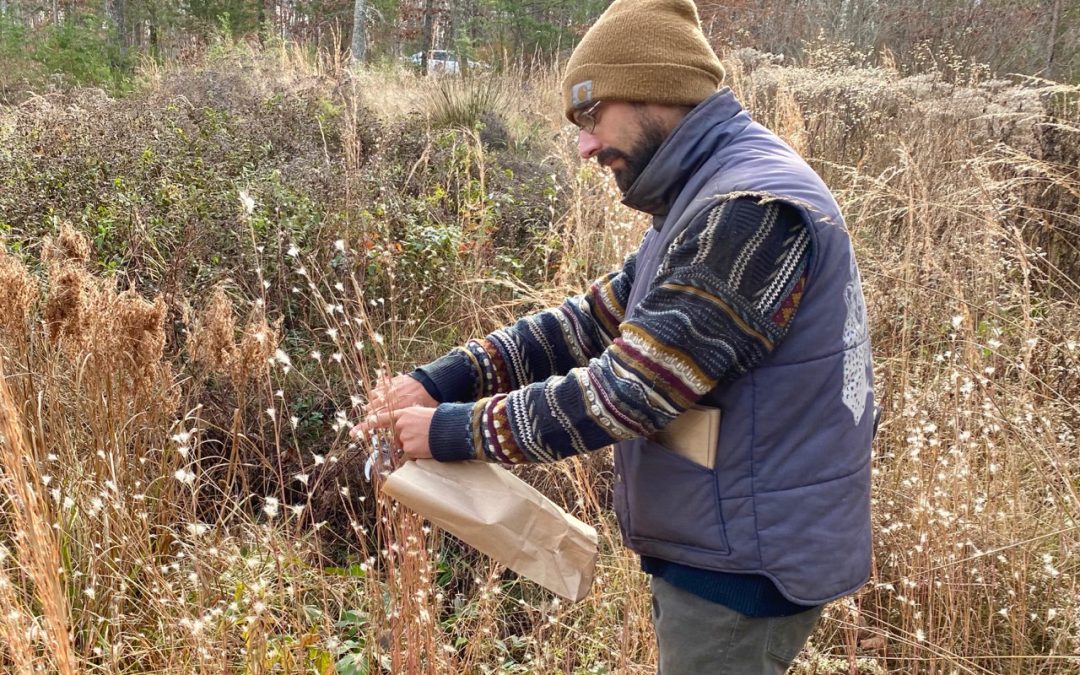
Dec 8, 2020
. . . to collect seeds. With summer’s flowers now a memory, a crew from Little Bluestem Nursery spent a beautiful morning at The Quarry Gardens last week collecting seeds of prairie plants to propagate over the winter and spring.
In the featured photo, the nursery’s principal Ben Kessler is cutting Splitbeard bluestem, Andropogon ternarius, a native grass that shines in sunlight.
Among other seeds, they also collected:
– Hoary mountain mint, Pycnanthemum incanum
– Inland sea oats, Chasmanthium latifolium
– Wild indigo, Baptisia tinctoria
– Curlyheads, Clematis orchraleuca
– Pink muhly grass, Muhlenbergia capillaris
– Black-eyed susan, Rudbeckia hirta
– Switchgrass, Panicum virgatum
– Shrubby St. John’s wort, Hypericum prolificum
– Purple lovegrass, Eragrostis spectabilis
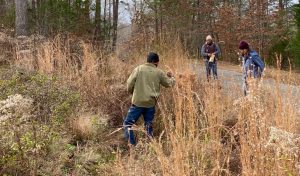
Above, others of the group forage among the nearly 100 species to be found in the demonstration gardens near the Visitor Center. Here, Wool grass, Scirpus cyperinus, seems to be the focus.
Little Bluestem is a non-profit nursery in Afton, Virginia, that seeds, tends and distributes native plants of our regional ecosystems that are not readily available in the trade. The nursery offers for sale trays of plugs and some quarts; the list may be found at littlebluestem.net
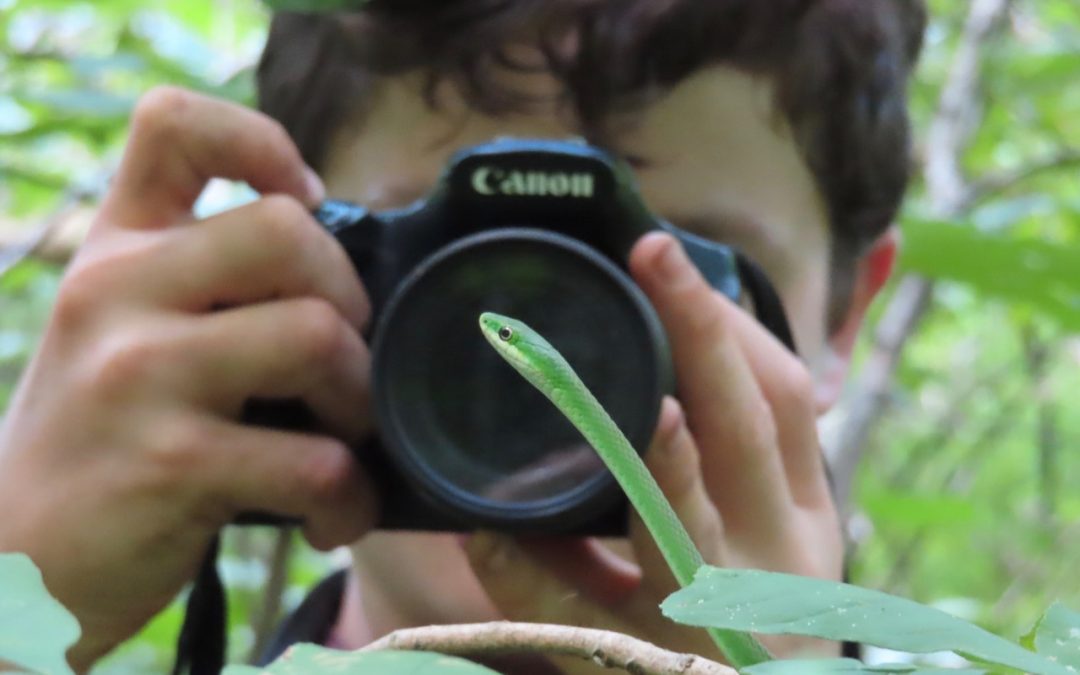
Sep 27, 2020
The Quarry Gardens’ 40 acres are buffered by a 400-acre Virginia Outdoors conservation easement. That land includes three forest community types fronting the Rockfish River, where Devin Floyd, of the Center for Urban Habitats, led a survey team of six in August.
Above is a Rough green snake, Opheodrys aestivus, having its portrait made by Theo Staengl. The green snake was one of nine reptiles or amphibians observed in the two-day survey. The survey team also included field technicians/photographers Ezra Staengl, Drew Chaney, Olivia Lewis, and Emily Luebke.
The forest community types—Acidic Cliffs, Hemlock-Hardwood Bluffs, and Boulderfield Forest—are steep and generally north-facing. They host a number of plant species more typical of the Appalachian mountains to the west, only rarely found and poorly documented in the Piedmont.
Acidic cliffs
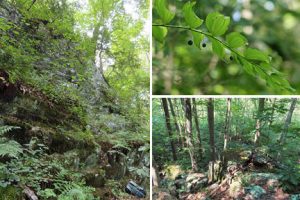
These images by Devin show a section of the cliffs from below and above (the tiny blue dot on the left side of the lower right photo is one of the crew). At top left, the Smooth solomon’s seal, Polygonatum biflorum, caught by Ezra reveals seldom-seen seeds where twin white flowers bloomed in April.
Hemlock-Hardwood Bluffs
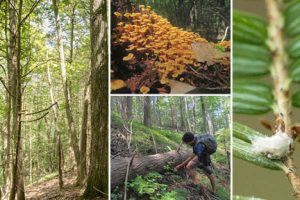
The hemlock forest is ranked S1 (critically imperiled) by Virginia DCR’s Natural Heritage Division, in part because it requires very specific conditions—north-facing steep bluffs fronting a stream—and because the introduced Hemlock woolly adelgids, Adelges tsugae, (at right, photographed by Emily) are killing the trees. At center bottom, Ezra is checking out animal hair caught on a fallen log. Above, Theo’s photo shows that where trees fall, mushrooms abound. The hemlock forest on its west side includes Chestnut oaks and shortleaf pines more than 200 years old. Ground level plants found here include Trailing arbutus, Partridgeberry, and Hay-scented fern.
Boulderfield Forest
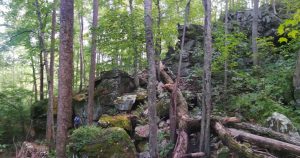
The acidic Boulderfield forest, estimated at 90-120 years old, is dominated by a canopy of Umbrella magnolia and Red maple with large colonies of evergreen Intermediate woodfern on the floor—and little in between. Native Red mulberry and Ilex montana (normally a mountain species) were noted in the survey plot and Pinxterbloom azalea and hybrid Highbush blueberry outside of it. Note the tiny surveyer in blue at lower left; photo by Devin.
For the record
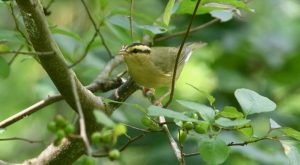
Thirty species of birds were noted including the Worm-eating warbler, above, along with Hooded warbler, Black-and-white warbler, Louisiana waterthrush, and the first Great egret seen on the property.
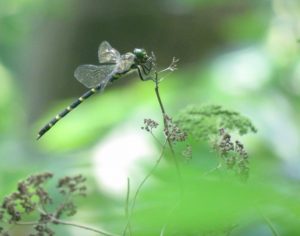
Fourteen species of Odonata were observed, including the uncommon Tiger spiketail, above, a secretive species that breeds in forested seeps and streams, photographed by Theo. Though butterflies prefer open sunny areas to forests, nevertheless, six species were observed, including the uncommon Gemmed satyr. Six moth species were also observed.
The surveys captured a number of species new to the property record, and one—Kral’s sedge, Carex kraliana—county first.
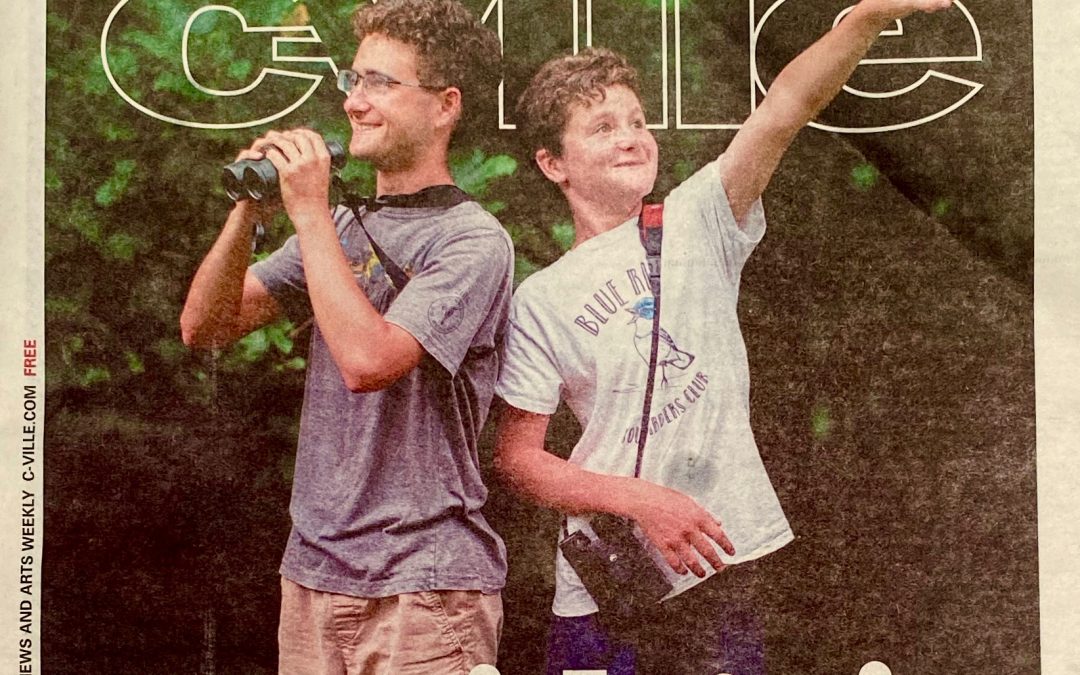
Aug 5, 2020
Our favorite birders, brothers Ezra and Theo Staengl, are featured in this week’s Cville. The article by Carol Diggs describes an evening walk in search of woodcocks.
Now 16 and 14, Ezra and Theo are mainstays of the Blue Ridge Young Birders Club for avian enthusiasts aged 7-18. The club meets monthly at Ivy Creek Natural Area and runs at least one field trip a month elsewhere. Their mother Joanne Saladis is the coordinating adult.
In 2017, the boys compiled photographs and wrote descriptions for the digital bird show in The Quarry Gardens Visitor Center. The show features 29 of the 80 avian species that have been identified here. (The full list may be found by scrolling through the consolidated database linked to The Gardens page on the website.)
Ezra and Theo have led bird walks for the public at QGs during migrations. We’re hoping to join them this fall.
Learn more about the club at blueridgeyoungbirdersclub.org.














